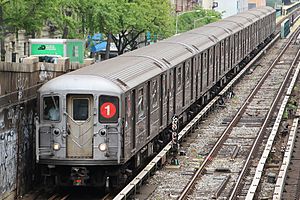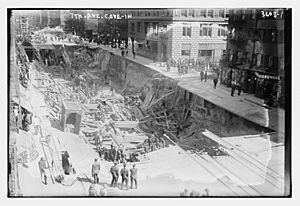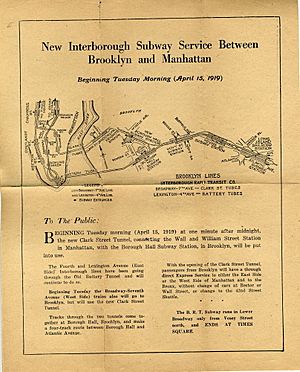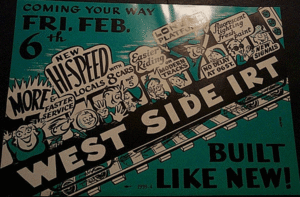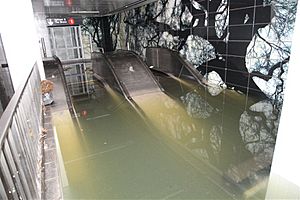IRT Broadway–Seventh Avenue Line facts for kids
Quick facts for kids IRT Broadway–Seventh Avenue Line |
|
|---|---|
  
The 1, 2, and 3, which use the Broadway–Seventh Avenue Line through Midtown Manhattan, are colored red.
|
|
| Overview | |
| Owner | City of New York |
| Termini | Van Cortlandt Park–242nd Street
|
| Stations | 44 |
| Service | |
| Type | Rapid transit |
| System | New York City Subway |
| Operator(s) | New York City Transit Authority |
| Daily ridership | 1,116,275 (2016, weekday) |
| History | |
| Opened | 1904–1919 |
| Technical | |
| Number of tracks | 1–4 |
| Character |
|
| Track gauge | 4 ft 8 1⁄2 in (1,435 mm) |
| Electrification | 625V DC third rail |
The IRT Broadway–Seventh Avenue Line is an important New York City Subway line. It runs from South Ferry in Lower Manhattan all the way north to Van Cortlandt Park–242nd Street in the Bronx. There's also a branch that goes southeast from Chambers Street in Manhattan, through the Clark Street Tunnel, to Borough Hall in Downtown Brooklyn.
This subway line was built in two main parts by a company called the Interborough Rapid Transit Company (IRT). The first part opened between 1904 and 1908. It was part of the city's very first subway system. The second part was built later as part of the "Dual Contracts." These contracts were agreements between the IRT, another company, and New York City.
The new sections of the line helped reduce crowding on other subway lines. They also opened up subway service to new parts of the city. For example, people could now easily get to Penn Station, a major train hub. The arrival of the subway also helped rebuild and improve Manhattan's West Side.
Over the years, the way trains run on the line has been made simpler. For example, in the late 1950s, local trains were sent one way and express trains another. This helped avoid delays. Some stations were also updated, and platforms were made longer. The Cortlandt Street station was rebuilt and reopened in 2018 after being damaged in the September 11 attacks. The South Ferry station was also rebuilt after being flooded by Hurricane Sandy.
Contents
Exploring the Broadway–Seventh Avenue Line
The IRT Broadway–Seventh Avenue Line is also known as the IRT West Side Line. This is because it runs along the west side of Manhattan. The line starts in the Bronx near the border with Westchester. It ends at the very tip of Lower Manhattan.
Along its route, the line connects many important places. These include Times Square, Lincoln Center, Columbia University, and the City College of New York. The part of the line north of 42nd Street was built as part of New York's very first subway in 1904.
Train Services on the Line
The subway trains that use the IRT Broadway–Seventh Avenue Line are colored red on subway maps and signs. These are the 1 2 3 trains trains. They run together for most of the line.
Between 1989 and 2005, the 1 train and the 9 train used a "skip-stop" service. This meant that the 1 and 9 trains would skip different stations in Upper Manhattan. The goal was to make rides faster without needing a separate express track. However, this service was stopped in 2005. It was found that it didn't help many people, and stopping it allowed more trains to run.
Tracks and Train Yards
Most of the line north of 96th Street has a third track. This track used to be for express trains during busy times. Today, it is mostly used when other tracks are being repaired. There is another unused third track further north, between Dyckman Street and Van Cortlandt Park–242nd Street.
The line also connects to three train yards where subway cars are stored and maintained.
- The 240th Street Yard is near Van Cortlandt Park–242nd Street. It can hold all the trains for the 1 service.
- The 207th Street Yard stores some trains used during rush hours. It also cleans and repairs trains.
- The 137th Street Yard has tracks for trains that turn around during rush hour.
The Clark Street Tunnel Connection
The Clark Street Tunnel carries the 2 and 3 train trains under the East River. This tunnel connects the boroughs of Manhattan and Brooklyn. It opened on April 15, 1919. It helped reduce crowding in another tunnel and gave people a direct way to travel between Brooklyn and Manhattan's west side.
The tunnel is about 5,900 feet (1,800 meters) long. About 3,100 feet (940 meters) of it is underwater. Building the tunnel started in 1914. Workers used a special "tunneling shield" and compressed air to dig it. Hundreds of men worked 24 hours a day to dig the tunnels.
Sadly, on December 28, 1990, an electrical fire happened in the Clark Street Tunnel. Two people died, and many others were hurt.
Building the Subway Line
Early Construction: Contracts 1 and 2
The very first subway in New York City started running on October 27, 1904. This included many stations on what is now the Broadway–Seventh Avenue Line. Most of this early line was underground. However, the section around 125th Street was elevated. It ran on a viaduct to cross a deep valley.
Over the next few years, the line was extended further north. By August 1, 1908, trains were running all the way to 242nd Street. Before 1918, trains on the West Side Branch ran from Lower Manhattan to Van Cortlandt Park. They used parts of what are now the Lexington Avenue, 42nd Street, and Broadway–Seventh Avenue Lines.
The Dual Contracts and Expansion
The "Dual Contracts" were signed on March 19, 1913. These were agreements to build and improve subway lines in New York City. As part of these contracts, the IRT agreed to build a new branch of the subway. This branch would go south along Seventh Avenue and other streets to serve the West Side of Manhattan.
This new construction changed how the IRT subway system worked. Instead of trains making a "Z" shape on the map, the system became an "H" shape. One main line would run along Lexington Avenue, and the other along the new Seventh Avenue line. The 42nd Street Shuttle would connect them. To build the new line, some streets had to be made wider, and new streets were created. People believed the subway would help the Lower West Side grow.
Building the extension started in 1914. In some areas, the subway was built in an "open-cut." This means they dug a big trench from the surface. In other areas, like under Battery Park, it was built underground. Many buildings had to be supported during construction.
South of Chambers Street, the line split into two branches. One branch went to South Ferry. The second branch went east under Park Place and then into Brooklyn through a tunnel under the East River. This Brooklyn branch had very steep slopes to go under other subway lines.
During construction, there was an accident on September 22, 1915. An explosion at the 23rd Street subway station caused the tunnel to collapse. Seven people died when a trolley car and a truck fell into the hole.
Opening the New Sections
The first part of the Broadway–Seventh Avenue Line south of Times Square–42nd Street opened on June 3, 1917. It was a short shuttle service to 34th Street–Penn Station. This section opened early to help people get to Penn Station.
On August 1, 1918, the new "H" system was fully put into place. This connected the two halves of the Broadway–Seventh Avenue Line. All West Side trains now went south from Times Square. This change doubled the capacity of the IRT subway system.
The local trains went to South Ferry. The express trains used the Brooklyn branch to Wall Street. This express service was extended to Atlantic Avenue in Brooklyn through the Clark Street Tunnel on April 15, 1919. Over the next few years, more extensions opened in Brooklyn. This meant West Side trains could go to places like Flatbush Avenue or New Lots Avenue.
Modernizing the Line (1940s to 1990s)
In 1948, many station platforms on the line were made longer. This allowed for longer, ten-car express trains to stop. Before this, stations could only fit shorter trains. The platform extensions were opened in different stages throughout 1948.
In the early 1950s, there was a plan to make the Columbus Circle station an express stop. This was because a new building, the New York Coliseum, was expected to bring more riders.
A big rebuilding program in the late 1950s improved the 1 train service. Before this, trains from different lines had to switch tracks, causing delays. On February 6, 1959, this problem was fixed. All Broadway trains became local trains, and all Lenox Avenue trains became express trains. This meant trains no longer needed to switch tracks.
As part of these changes, the 91st Street station was closed on February 2, 1959. It was too close to the newly extended 86th Street and 96th Street stations.
In 1961, the New York City Transit Authority (NYCTA) upgraded the line's signals. In 1964, they started a project to lengthen platforms at more stations. This allowed all trains to be ten cars long. By 1965, platforms in Brooklyn were also lengthened.
On August 21, 1989, the 1/9 weekday skip-stop service began. This service was meant to speed up travel. However, it was only used north of 137th Street–City College during certain hours. The 1 train skipped some stations, and the 9 train skipped others. This skip-stop service was stopped during midday hours in 1994.
The Broadway–Seventh Avenue Line in the 21st Century
After the September 11 attacks in 2001, the 1 train service was changed. The line ran directly under the World Trade Center site and was badly damaged. For a while, 1 trains only ran between 242nd Street and 14th Street. The skip-stop service was also stopped.
On September 15, 2002, 1 trains returned to the South Ferry Loop. The 9 skip-stop service also started again. The Cortlandt Street station, which was destroyed, was rebuilt and reopened on September 8, 2018.
In 2002, the Metropolitan Transportation Authority (MTA) announced plans to renovate ten subway stations. This included five stations on the IRT Broadway–Seventh Avenue Line. The renovations would update fare areas, flooring, and electrical systems. They would also add new lighting and public address systems. For stations with landmark status, historical elements would be restored.
Some community groups were concerned about new artwork being added to historic stations. They worried it might damage the original designs. After discussions, the idea of adding new art to the landmarked stations was dropped. Columbia University helped fund some of these renovations.
On May 27, 2005, the 9 train service was completely stopped. All 1 trains began making all local stops. The MTA found that ending skip-stop service only added a few minutes to travel time for some riders. However, it doubled how often trains came for many others, making overall travel faster.
On March 16, 2009, a new South Ferry station opened. It replaced the old loop station. The old station could only fit the first five cars of a train. The new station was built with two tracks and could fit full ten-car trains. This new station made trips faster and allowed more trains to run per hour.
In October 2012, Hurricane Sandy caused serious flood damage to the new South Ferry station. The old loop station had to be reopened temporarily in 2013. Hurricane Sandy also damaged the Clark Street Tunnels. This led to weekend closures for repairs from 2017 to 2018. The new South Ferry station reopened on June 27, 2017. Normal service on the Brooklyn Branch returned on June 25, 2018.
Stations Along the Line
The IRT Broadway–Seventh Avenue Line serves many neighborhoods in the Bronx, Manhattan, and Brooklyn. Here is a list of its stations:
| Neighborhood (approximate) |
Station | Tracks | Services | Opened | Transfers and notes | |
|---|---|---|---|---|---|---|
| The Bronx | ||||||
| Riverdale | Van Cortlandt Park–242nd Street | 1 alltimes | August 1, 1908 | |||
| Center Express track begins (no regular service) | ||||||
| Connecting Tracks to 240th Street Yard | ||||||
| Kingsbridge and Riverdale | 238th Street | local | 1 alltimes | August 1, 1908 | ||
| 231st Street | local | 1 alltimes | August 1, 1908 | |||
| Manhattan | ||||||
| Marble Hill | Marble Hill–225th Street | local | 1 alltimes | January 14, 1907 | Connection to Metro-North Railroad (Hudson Line) at Marble Hill | |
| Broadway Bridge | ||||||
| Inwood | 221st Street | local | March 12, 1906 | Closed January 14, 1907 | ||
| 215th Street | local | 1 alltimes | March 12, 1906 | |||
| Connecting Track to 207th Street Yard | ||||||
| 207th Street | local | 1 alltimes | April 1, 1907 | Bx12 Select Bus Service | ||
| Center Express track ends | ||||||
| Lua error in Module:Adjacent_stations at line 82: lineN was "Broadway-Seventh" but neither an entry for it nor a default was found. Choices were: Eighth far north, Broadway-7th, none, Eighth, Broadway-7th north, Broadway-7th local. | 1 alltimes | March 12, 1906 | ||||
| Washington Heights | 191st Street | 1 alltimes | January 14, 1911 | |||
| Lua error in Module:Adjacent_stations at line 82: lineN was "Broadway-Seventh" but neither an entry for it nor a default was found. Choices were: Eighth far north, Eighth, Broadway-7th north, Broadway-7th. | 1 alltimes | May 30, 1906 | ||||
| Lua error in Module:Adjacent_stations at line 82: lineN was "Broadway-Seventh" but neither an entry for it nor a default was found. Choices were: Eighth local 145th, Eighth local far south via Fulton, Eighth express 145th, Eighth far north, Jamaica, Eighth local south, Broadway-7th, Fulton local, Eighth, Broadway-7th north, Eighth local north. | 1 alltimes | April 14, 1906 | IND Eighth Avenue Line (A alltimes C allexceptnights) | |||
| 157th Street | 1 alltimes | November 12, 1904 | Bx6 Select Bus Service | |||
| Center Express track begins (No Regular Service) | ||||||
| Harlem | Lua error in Module:Adjacent_stations at line 82: lineN was "Broadway-Seventh" but neither an entry for it nor a default was found. Choices were: Concourse, Lenox far north, Broadway-7th local, Concourse local, Concourse express, Eighth local, Broadway-7th north, Eighth local north, Eighth local 145th, Lenox, Eighth express, none, Broadway-7th, Eighth local via Sixth, Lenox north, Eighth, Eighth express north. | local | 1 alltimes | October 27, 1904 | ||
| 137th Street Yard tracks surround Main Line | ||||||
| 137th Street–City College | local | 1 alltimes | October 27, 1904 | |||
| Lua error in Module:Adjacent_stations at line 82: lineN was "Broadway-Seventh" but neither an entry for it nor a default was found. Choices were: Jerome express, Eighth express 145th, Broadway-7th local, Eighth local, Lexington express, Pelham local, Eighth express via Concourse express, Eighth express 59th, Lexington local, Lenox, Pelham express, Lexington, Jerome local via White Plains, Lenox via White Plains, Jerome local south, Broadway-7th, Eighth express via Concourse local, Lenox north, Eighth, Eighth express via Sixth. | local | 1 alltimes | October 27, 1904 | |||
| Morningside Heights | 116th Street–Columbia University | local | 1 alltimes | October 27, 1904 | M60 Select Bus Service to LaGuardia Airport | |
| Lua error in Module:Adjacent_stations at line 82: lineN was "Broadway-Seventh" but neither an entry for it nor a default was found. Choices were: Eighth local, Broadway-7th local, Eighth, Broadway-7th. | local | 1 alltimes | October 27, 1904 | |||
| Upper West Side | Lua error in Module:Adjacent_stations at line 82: lineN was "Broadway-Seventh" but neither an entry for it nor a default was found. Choices were: Lexington, Broadway-7th, Lexington local, Eighth local, Eighth, Broadway-7th local. | local | 1 alltimes | October 27, 1904 | ||
| Center Express track ends | ||||||
| IRT Lenox Avenue Line joins as the express tracks (2 alltimes 3 alltimes) | ||||||
| Lua error in Module:Adjacent_stations at line 82: lineN was "Broadway-Seventh" but neither an entry for it nor a default was found. Choices were: Eighth local, 63rd BMT, Broadway express north, Lenox, Second, Broadway-7th local, Lexington local, Lexington, Broadway-7th express, Broadway-7th, Lexington express, Lenox via White Plains, Eighth, none. | all | 1 alltimes 2 alltimes 3 alltimes | October 27, 1904 | |||
| 91st Street | local | October 27, 1904 | Closed February 2, 1959 | |||
| Lua error in Module:Adjacent_stations at line 82: lineN was "Broadway-Seventh" but neither an entry for it nor a default was found. Choices were: Fourth south, Lexington, Lexington local, Second, Sea Beach local, Broadway-7th local, Sea Beach, Lexington express via Jerome, Broadway-7th express, Broadway-7th, Fourth, Lexington express, Eighth, Eighth local. | local | 1 alltimes 2 nightsonly | October 27, 1904 | M86 Select Bus Service | ||
| Lua error in Module:Adjacent_stations at line 82: lineN was "Broadway-Seventh" but neither an entry for it nor a default was found. Choices were: West End local, West End, Broadway-7th local, Broadway-7th. | local | 1 alltimes 2 nightsonly | October 27, 1904 | M79 Select Bus Service | ||
| Lua error in Module:Adjacent_stations at line 82: lineN was "Broadway-Seventh" but neither an entry for it nor a default was found. Choices were: Eighth local 59th, 63rd BMT, Broadway-7th local, Broadway-7th express, Broadway-7th, Second, Eighth local via Sixth, Eighth, Eighth local. | all | 1 alltimes 2 alltimes 3 alltimes | October 27, 1904 | |||
| 66th Street–Lincoln Center | local | 1 alltimes 2 nightsonly | October 27, 1904 | |||
| Midtown | Lua error in Module:Adjacent_stations at line 82: lineN was "Broadway-Seventh" but neither an entry for it nor a default was found. Choices were: Eighth local, Eighth local 50th, Sixth express, Broadway-7th, Eighth express south, Eighth express, Eighth, Broadway-7th local. | local | 1 alltimes 2 nightsonly | October 27, 1904 | IND Eighth Avenue Line (A alltimes B weekdaysonly C allexceptnights D alltimes) | |
| Lua error in Module:Adjacent_stations at line 82: lineN was "Broadway-Seventh" but neither an entry for it nor a default was found. Choices were: Eighth local 59th, Broadway-7th local, none, West End local, Eighth local south, Broadway-7th, Queens, Queens far west, Eighth, West End. | local | 1 alltimes 2 nightsonly | October 27, 1904 | |||
| merge on northbound local track to IRT 42nd Street Line (no regular service) | ||||||
| Lua error in Module:Adjacent_stations at line 82: lineN was "Broadway-Seventh" but neither an entry for it nor a default was found. Choices were: Broadway express north, Broadway-7th local, Broadway, Broadway-7th express, Broadway-7th, Broadway local north, Flushing, Broadway local, Broadway express. | all | 1 alltimes 2 alltimes 3 alltimes | June 3, 1917 | IRT Flushing Line (7 alltimes <7>rushpeak) IND Eighth Avenue Line (A alltimes C allexceptnights E alltimes) at 42nd Street–Port Authority Bus Terminal BMT Broadway Line (N alltimes Q alltimes R allexceptnights W weekdaysonly) 42nd Street Shuttle (S allexceptnights) IND Sixth Avenue Line (B weekdaysonly D alltimes F alltimes M weekdaysonly) at 42nd Street–Bryant Park, daytime only Port Authority Bus Terminal |
||
| Lua error in Module:Adjacent_stations at line 82: lineN was "Broadway-Seventh" but neither an entry for it nor a default was found. Choices were: Broadway-7th express, Broadway-7th, Eighth local south, Eighth express south, Eighth, Broadway-7th local. | all | 1 alltimes 2 alltimes 3 allexceptnights | June 3, 1917 | Connection to Amtrak, LIRR, and N.J. Transit at Pennsylvania Station M34 / M34A Select Bus Service |
||
| Chelsea | Lua error in Module:Adjacent_stations at line 82: lineN was "Broadway-Seventh" but neither an entry for it nor a default was found. Choices were: Broadway, Broadway-7th, Lexington local, Lexington, Broadway local, Broadway-7th local. | local | 1 alltimes 2 nightsonly | July 1, 1918 | ||
| Lua error in Module:Adjacent_stations at line 82: lineN was "Broadway-Seventh" but neither an entry for it nor a default was found. Choices were: Lexington, Lexington local, Broadway-7th local, Broadway, Eighth local south, Broadway-7th, Sixth local, Sixth, Broadway local, Eighth. | local | 1 alltimes 2 nightsonly | July 1, 1918 | M23 Select Bus Service | ||
| Lua error in Module:Adjacent_stations at line 82: lineN was "Broadway-Seventh" but neither an entry for it nor a default was found. Choices were: none, Lexington, Broadway-7th local, Broadway-7th. | local | 1 alltimes 2 nightsonly | July 1, 1918 | |||
| Lua error in Module:Adjacent_stations at line 82: lineN was "Broadway-Seventh" but neither an entry for it nor a default was found. Choices were: Sixth local, Sixth, Broadway-7th express, Broadway-7th, Eighth local south, Eighth express south, Eighth, Broadway-7th local. | all | 1 alltimes 2 alltimes 3 allexceptnights | July 1, 1918 | Out-of-system transfers with MetroCard/OMNY: IND Sixth Avenue Line (F alltimes <F>rushpeak M weekdaysonly) at 14th Street BMT Canarsie Line (L alltimes) at Sixth Avenue Connection to PATH at 14th Street M14A / M14D Select Bus Service |
||
| Greenwich Village | Christopher Street–Sheridan Square | local | 1 alltimes 2 nightsonly | July 1, 1918 | ||
| Houston Street | local | 1 alltimes 2 nightsonly | July 1, 1918 | |||
| TriBeCa | Lua error in Module:Adjacent_stations at line 82: lineN was "Broadway-Seventh" but neither an entry for it nor a default was found. Choices were: Lexington, Broadway south via bridge, Broadway-7th local, Broadway, Nassau, Fourth express, Eighth express 59th, Lexington local, Eighth express far south, Broadway south, Eighth express south, Nassau north, Eighth local south, Broadway-7th, Fourth local via Bridge, Eighth local far south, Eighth, Broadway express. | local | 1 alltimes 2 nightsonly | July 1, 1918 | ||
| Franklin Street | local | 1 alltimes 2 nightsonly | July 1, 1918 | |||
| Financial District | Lua error in Module:Adjacent_stations at line 82: lineN was "Broadway-Seventh" but neither an entry for it nor a default was found. Choices were: Nassau, Eighth local far south via Fulton, Eighth express far south, Broadway-7th local, Broadway-7th via Eastern, Broadway-7th express, Broadway-7th, JFK Express, Eighth express south, Broadway-7th south, Eighth. | all | 1 alltimes 2 alltimes 3 allexceptnights | July 1, 1918 | ||
| Express tracks split to Brooklyn Branch (2 alltimes 3 allexceptnights); Local tracks continue as Main line (1 alltimes) | ||||||
| WTC Cortlandt | local | 1 alltimes | July 1, 1918 | Closed from September 11, 2001 to September 8, 2018 due to damage sustained in the September 11 attacks Connection to PATH at World Trade Center |
||
| Lua error in Module:Adjacent_stations at line 82: lineN was "Broadway-Seventh" but neither an entry for it nor a default was found. Choices were: Broadway, Broadway Whitehall via tunnel, Broadway-7th, Broadway-7th south, Broadway south, Broadway Whitehall. | local | 1 alltimes | July 1, 1918 | |||
| Split between Main line and Outer loop at South Ferry | ||||||
| South Ferry (Loop Platform) |
outer loop | July 1, 1918 | Closed on March 16, 2009 with the opening of the new terminal Reopened on April 4, 2013 as temporary terminal; closed again on June 27, 2017 |
|||
| Lua error in Module:Adjacent_stations at line 82: lineN was "Broadway-Seventh" but neither an entry for it nor a default was found. Choices were: none, Broadway-7th express, Broadway-7th, Lexington, Broadway-7th south, Broadway-7th north, Broadway-7th local. (New Platform) |
local | 1 alltimes | March 16, 2009 | Closed November 2012 due to damage caused by Hurricane Sandy; reopened on June 27, 2017 BMT Broadway Line (N nightsonly R allexceptnights W weekdaysonly) at Whitehall Street–South Ferry M15 Select Bus Service Staten Island Ferry at South Ferry |
||
| Main line terminates (1 alltimes) | ||||||
| Brooklyn Branch (2 alltimes 3 allexceptnights) | ||||||
| Financial District | Lua error in Module:Adjacent_stations at line 82: lineN was "Broadway-Seventh" but neither an entry for it nor a default was found. Choices were: Franklin, Broadway-7th via Eastern, Broadway-7th express, Broadway-7th. | express | 2 alltimes 3 allexceptnights | July 1, 1918 | BMT Broadway Line (N nightsonly R allexceptnights W weekdaysonly) at Cortlandt Street IND Eighth Avenue Line (A alltimes C allexceptnights) at Chambers Street IND Eighth Avenue Line (E alltimes) at World Trade Center Connection to PATH at World Trade Center |
|
| Lua error in Module:Adjacent_stations at line 82: lineN was "Broadway-Seventh" but neither an entry for it nor a default was found. Choices were: Nassau, Lexington, Eighth express far south, Broadway-7th via Eastern, Lexington south, Broadway-7th, Lexington express, Eighth, Crosstown. | express | 2 alltimes 3 allexceptnights | July 1, 1918 | IRT Lexington Avenue Line (4 alltimes 5 allexceptnights) IND Eighth Avenue Line (A alltimes C allexceptnights) BMT Nassau Street Line (J alltimes Z rushpeak) Connection to PATH at World Trade Center |
||
| Lua error in Module:Adjacent_stations at line 82: lineN was "Broadway-Seventh" but neither an entry for it nor a default was found. Choices were: Broadway-7th via Eastern, Lexington south, Broadway-7th, Lexington, Eastern express. | express | 2 alltimes 3 allexceptnights | July 1, 1918 | |||
| Brooklyn | ||||||
| Clark Street Tunnel | ||||||
| Brooklyn Heights | Clark Street | express | 2 alltimes 3 allexceptnights | April 15, 1919 | ||
| Downtown Brooklyn | Lua error in Module:Adjacent_stations at line 82: lineN was "Broadway-Seventh" but neither an entry for it nor a default was found. Choices were: Broadway-7th via Eastern, Lexington south, Broadway-7th, Eastern, Eastern local, Eastern express. | express | 2 alltimes 3 allexceptnights | April 15, 1919 | IRT Eastern Parkway Line (4 alltimes 5 weekdaysonly) BMT Fourth Avenue Line (N nightsonly R alltimes W rushonly) at Court Street |
|
| becomes the local tracks of the IRT Eastern Parkway Line (2 alltimes 3 allexceptnights) | ||||||
Images for kids
See also
 In Spanish: L%C3%ADnea de la S%C3%A9ptima Avenida-Broadway para ni%C3%B1os
In Spanish: L%C3%ADnea de la S%C3%A9ptima Avenida-Broadway para ni%C3%B1os


